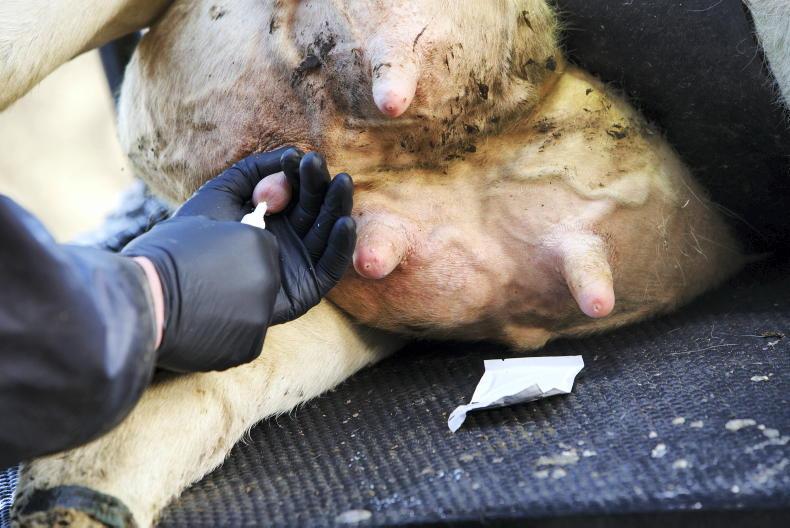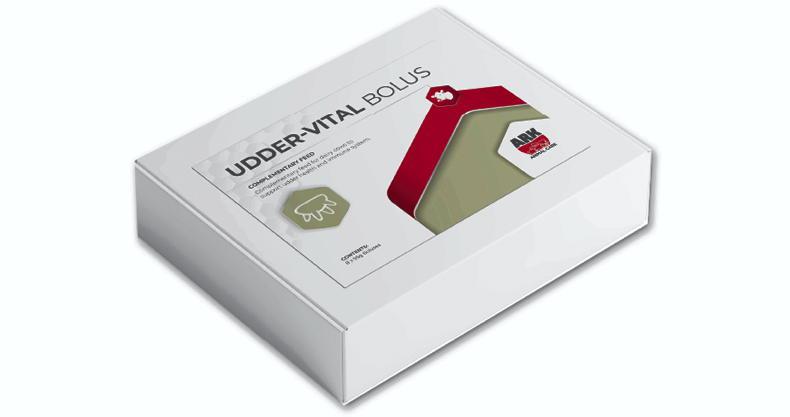CellCheck has developed a new in-lactation consult, called Cell Count Solutions, to help farmers who are having difficulty in managing mastitis and somatic cell count (SCC) levels on their farms.
This three-hour veterinary-led Targeted Advisory Service on Animal Health (TASAH) consult is free to farmers, and funded under the Rural Development Plan 2014-2022, by the Department of Agriculture, Food and the Marine, in conjunction with the EU.
As mastitis is a multifactorial problem, it requires a multidisciplinary approach.
Although TASAH-funded consults are vet-led, a key objective of the consult is to identify any other service providers that farmers seek help and advice from, and kickstart a collaborative approach to addressing mastitis.
These service providers could include Teagasc and private farm advisers, milk quality advisers and milking machine technicians.
Previous research has found that successfully using a farmer-led multidisciplinary team improves herd health management and engagement with consult recommendations.
Mastitis can result in significant losses on any farm and, when prevalent, it can significantly reduce farm profits. When calculating the true cost of mastitis to farmers, it is easy to include the obvious ones, but the hidden costs have to be considered too.
Lost bonuses and penalties
These costs include lost bonuses or penalties, production losses and stress to the farmer. As well as looking at relevant costings and calculating economic benefits, the consult is an opportunity to look at all available farm information, milking routines, cows and their environment.
The consult may also involve collection of any necessary milk samples and collaborating with the herdowner and farm staff to create tailored recommendations specific to the farm involved. Early remedial actions are identified, which may be for further investigation and/or to address challenges already identified.
There are no eligibility criteria for farmers to participate in this consult. It is intended that the consult will be provided by their own trained veterinary practitioner.
They will also have the option to identify and connect the additional service providers (milk quality adviser, farm adviser, milking machine technician, etc), who will ideally be part of the initial consult and will receive the agreed action plan post-consult to provide ongoing support.
Producing high-quality milk is a priority for dairy farmers but in the past farmers have often found the lack of a “joined-up” approach to mastitis control challenging.
Depending on who they seek help or advice from, the perspective and advice may appear conflicting. Many of the service providers that can influence farmer behaviour have little or no contact with each other.
Together, the collaborative approach that is encouraged and facilitated though the Cell Count Solutions consult, will promote a more preventative and holistic approach to mastitis control, which will ultimately improve milk quality.
Knowing how your herd is performing is the first step to getting mastitis under control.
To monitor performance, you need records. At a minimum, in order to “keep your finger on the pulse” of your herd’s performance, you need two types of records: SCC records and clinical case/treatment records.
Herd level SCC will give you a good overview of the udder health on your farm, as infected cows will increase the overall herd SCC. Monitoring the clinical case rate during lactation will measure the effectiveness of mastitis control throughout the year.

If you milk record, the CellCheck farm summary report that you receive after each milk recording allows you to identify patterns of infection in cows, eg those that have been recently infected.
You can also assess the proportion of the herd persistently infected, ie cows with a high SCC for the last two recordings. Use the Cost Check calculator to see how much a high-bulk tank SCC is truly costing you.
Cows can become infected from both environmental and contagious mastitis organisms. Here are some key tips to help prevent both during the lactation.
Evaluate the cow’s environment- collecting yards, roadways, around water troughs, and sheds if feeding inside. Clip tails to keep cows’ udders and teats clean.If housing was an issue on your farm last winter, begin planning now to increase cow accommodation. Having at least 11 cubicles per 10 cows during the housing period is vital to allow for normal cow behaviour, maximising hygiene and minimising the risk of mastitis.Assess the milking routine – wearing gloves, having a consistent routine, ensuring the teats are clean and dry. Forestripping, post-milking teat disinfection throughout the lactation and being calm in the parlour will all help to reduce the risk of mastitis. Carry out milk recording to identify problem cows and use a California mastitis test (CMT) to identify problem quarter(s). Collect a sterile sample and send to the lab to identify the bacteria causing the mastitis and the best treatment to use. Don’t forget to record any treatments given. Milk problem cows last or disinfect the cluster after milking a cow with a high SCC, either manually with diluted peracetic acid or automatically using a cluster flush system. Each cluster that milks one infected cow has the potential to infect the next five to seven cows it milks if not disinfected. Routine machine maintenance between services is crucial – see the CellCheck Farm Guidelines for more detail. Check liner condition and change the liners after every 2,000 milkings. This works out at approximately:– every 125 days (four months) in a 12-unit parlour that milks 96 cows, or
– every 125 days (four months) in a 16-unit parlour that milks 128 cows, or
– every 200 days (6.5 months) in a 20-unit parlour that milks 200 cows.
If high SCC or mastitis is a problem on your farm, register for a free Cell Count Solutions consult today and take the first step to improving mastitis control.
CellCheck has developed a new in-lactation consult, called Cell Count Solutions, to help farmers who are having difficulty in managing mastitis and somatic cell count (SCC) levels on their farms.
This three-hour veterinary-led Targeted Advisory Service on Animal Health (TASAH) consult is free to farmers, and funded under the Rural Development Plan 2014-2022, by the Department of Agriculture, Food and the Marine, in conjunction with the EU.
As mastitis is a multifactorial problem, it requires a multidisciplinary approach.
Although TASAH-funded consults are vet-led, a key objective of the consult is to identify any other service providers that farmers seek help and advice from, and kickstart a collaborative approach to addressing mastitis.
These service providers could include Teagasc and private farm advisers, milk quality advisers and milking machine technicians.
Previous research has found that successfully using a farmer-led multidisciplinary team improves herd health management and engagement with consult recommendations.
Mastitis can result in significant losses on any farm and, when prevalent, it can significantly reduce farm profits. When calculating the true cost of mastitis to farmers, it is easy to include the obvious ones, but the hidden costs have to be considered too.
Lost bonuses and penalties
These costs include lost bonuses or penalties, production losses and stress to the farmer. As well as looking at relevant costings and calculating economic benefits, the consult is an opportunity to look at all available farm information, milking routines, cows and their environment.
The consult may also involve collection of any necessary milk samples and collaborating with the herdowner and farm staff to create tailored recommendations specific to the farm involved. Early remedial actions are identified, which may be for further investigation and/or to address challenges already identified.
There are no eligibility criteria for farmers to participate in this consult. It is intended that the consult will be provided by their own trained veterinary practitioner.
They will also have the option to identify and connect the additional service providers (milk quality adviser, farm adviser, milking machine technician, etc), who will ideally be part of the initial consult and will receive the agreed action plan post-consult to provide ongoing support.
Producing high-quality milk is a priority for dairy farmers but in the past farmers have often found the lack of a “joined-up” approach to mastitis control challenging.
Depending on who they seek help or advice from, the perspective and advice may appear conflicting. Many of the service providers that can influence farmer behaviour have little or no contact with each other.
Together, the collaborative approach that is encouraged and facilitated though the Cell Count Solutions consult, will promote a more preventative and holistic approach to mastitis control, which will ultimately improve milk quality.
Knowing how your herd is performing is the first step to getting mastitis under control.
To monitor performance, you need records. At a minimum, in order to “keep your finger on the pulse” of your herd’s performance, you need two types of records: SCC records and clinical case/treatment records.
Herd level SCC will give you a good overview of the udder health on your farm, as infected cows will increase the overall herd SCC. Monitoring the clinical case rate during lactation will measure the effectiveness of mastitis control throughout the year.

If you milk record, the CellCheck farm summary report that you receive after each milk recording allows you to identify patterns of infection in cows, eg those that have been recently infected.
You can also assess the proportion of the herd persistently infected, ie cows with a high SCC for the last two recordings. Use the Cost Check calculator to see how much a high-bulk tank SCC is truly costing you.
Cows can become infected from both environmental and contagious mastitis organisms. Here are some key tips to help prevent both during the lactation.
Evaluate the cow’s environment- collecting yards, roadways, around water troughs, and sheds if feeding inside. Clip tails to keep cows’ udders and teats clean.If housing was an issue on your farm last winter, begin planning now to increase cow accommodation. Having at least 11 cubicles per 10 cows during the housing period is vital to allow for normal cow behaviour, maximising hygiene and minimising the risk of mastitis.Assess the milking routine – wearing gloves, having a consistent routine, ensuring the teats are clean and dry. Forestripping, post-milking teat disinfection throughout the lactation and being calm in the parlour will all help to reduce the risk of mastitis. Carry out milk recording to identify problem cows and use a California mastitis test (CMT) to identify problem quarter(s). Collect a sterile sample and send to the lab to identify the bacteria causing the mastitis and the best treatment to use. Don’t forget to record any treatments given. Milk problem cows last or disinfect the cluster after milking a cow with a high SCC, either manually with diluted peracetic acid or automatically using a cluster flush system. Each cluster that milks one infected cow has the potential to infect the next five to seven cows it milks if not disinfected. Routine machine maintenance between services is crucial – see the CellCheck Farm Guidelines for more detail. Check liner condition and change the liners after every 2,000 milkings. This works out at approximately:– every 125 days (four months) in a 12-unit parlour that milks 96 cows, or
– every 125 days (four months) in a 16-unit parlour that milks 128 cows, or
– every 200 days (6.5 months) in a 20-unit parlour that milks 200 cows.
If high SCC or mastitis is a problem on your farm, register for a free Cell Count Solutions consult today and take the first step to improving mastitis control.











SHARING OPTIONS